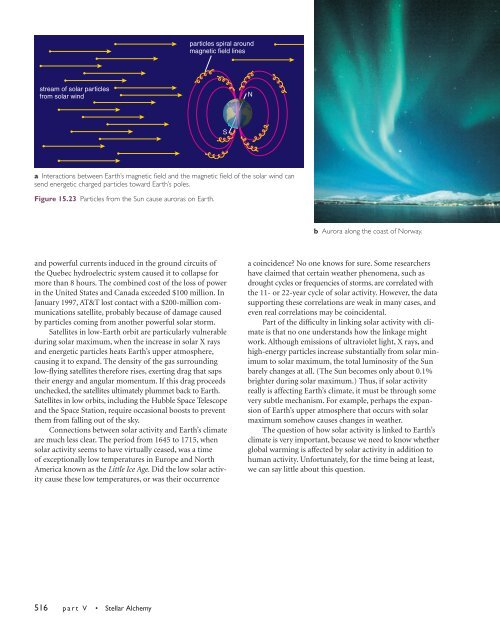Chapter 15--Our Sun - Geological Sciences
Chapter 15--Our Sun - Geological Sciences
Chapter 15--Our Sun - Geological Sciences
You also want an ePaper? Increase the reach of your titles
YUMPU automatically turns print PDFs into web optimized ePapers that Google loves.
particles spiral around<br />
magnetic field lines<br />
stream of solar particles<br />
from solar wind<br />
N<br />
S<br />
a Interactions between Earth’s magnetic field and the magnetic field of the solar wind can<br />
send energetic charged particles toward Earth’s poles.<br />
Figure <strong>15</strong>.23 Particles from the <strong>Sun</strong> cause auroras on Earth.<br />
b Aurora along the coast of Norway.<br />
and powerful currents induced in the ground circuits of<br />
the Quebec hydroelectric system caused it to collapse for<br />
more than 8 hours. The combined cost of the loss of power<br />
in the United States and Canada exceeded $100 million. In<br />
January 1997, AT&T lost contact with a $200-million communications<br />
satellite, probably because of damage caused<br />
by particles coming from another powerful solar storm.<br />
Satellites in low-Earth orbit are particularly vulnerable<br />
during solar maximum, when the increase in solar X rays<br />
and energetic particles heats Earth’s upper atmosphere,<br />
causing it to expand. The density of the gas surrounding<br />
low-flying satellites therefore rises, exerting drag that saps<br />
their energy and angular momentum. If this drag proceeds<br />
unchecked, the satellites ultimately plummet back to Earth.<br />
Satellites in low orbits, including the Hubble Space Telescope<br />
and the Space Station, require occasional boosts to prevent<br />
them from falling out of the sky.<br />
Connections between solar activity and Earth’s climate<br />
are much less clear. The period from 1645 to 17<strong>15</strong>, when<br />
solar activity seems to have virtually ceased, was a time<br />
of exceptionally low temperatures in Europe and North<br />
America known as the Little Ice Age. Did the low solar activity<br />
cause these low temperatures, or was their occurrence<br />
a coincidence? No one knows for sure. Some researchers<br />
have claimed that certain weather phenomena, such as<br />
drought cycles or frequencies of storms, are correlated with<br />
the 11- or 22-year cycle of solar activity. However, the data<br />
supporting these correlations are weak in many cases, and<br />
even real correlations may be coincidental.<br />
Part of the difficulty in linking solar activity with climate<br />
is that no one understands how the linkage might<br />
work.Although emissions of ultraviolet light, X rays, and<br />
high-energy particles increase substantially from solar minimum<br />
to solar maximum, the total luminosity of the <strong>Sun</strong><br />
barely changes at all. (The <strong>Sun</strong> becomes only about 0.1%<br />
brighter during solar maximum.) Thus, if solar activity<br />
really is affecting Earth’s climate, it must be through some<br />
very subtle mechanism. For example, perhaps the expansion<br />
of Earth’s upper atmosphere that occurs with solar<br />
maximum somehow causes changes in weather.<br />
The question of how solar activity is linked to Earth’s<br />
climate is very important, because we need to know whether<br />
global warming is affected by solar activity in addition to<br />
human activity. Unfortunately, for the time being at least,<br />
we can say little about this question.<br />
516 part V • Stellar Alchemy
















